GERMAN U-BOAT TELEPORTED
TO FIVE ISLAND LAKE, PART II
Palo Alto: December, 1944. The Third Reich is still crumbling. Meanwhile, at Ottumwa Naval Airstation, Lt. Commander Richard M. Nixon receives a frantic phone call from the tiny hamlet of Emmetsburg. Seconds later, he raises the alarm: "GERMAN SUB IN FIVE ISLAND LAKE, PALO ALTO CO., IOWA. THIS IS NOT AN EXCERCISE." Within minutes, nearly 60 planes are scrambled into the sky. Their mission: Kill the sub in Five Island Lake!
It was, in fact, the U-3036. After Hohenberg-Ristau had thrown the main power lever in Kiel, a massive surge, followed by a rapid acceleration of power in the quantum field generators (the exact cause and reasons are still heavily classified to this day, both in the US and the Federal Republic of Germany) occurred, causing the U-Boat to not only vanish, but teleport 3,375 miles across the Atlantic Ocean. What happened aboard the U-Boat is best described by her captain, Jurgen Wassergott.
"I had just signaled Captain von Hohenberg-Ristau that all of our systems were fully powered and operational. He then was to throw the main lever on shore, and we were to initiate the secondary power source in the generator aboard our own boat. This happened according to plan. But as soon as the switch on the my boat was engaged, strange things began to happen. The lights dimmed on board, and we started to shake. Many of the crew became frightened, and some of those topside tried to jump overboard and save themselves.
"This proved to be impossible, as I watched them try to leap overboard, only to be hurled back onto the deck as if they had run into a massive, invisible rubber wall. The next thing we knew, there was a rush of noise, and everyone experienced the sensation of watching the boat dissolve around them. Then we all blacked out. When we awoke, heavily disoriented, I might add, I said to my first officer, 'Well, Heinz, I don't think we're in Schleswig-Holstein anymore'".
Wassergott , who realized the need to restore discipline and morale in his badly shaken crew, immediately set about getting his boat ready for action. The first thing he had to do was determine, where, exactly, they were.
"This was not easy. The watch I set on the conning tower reported men on the shore, and thought they heard them speaking English. It occurred to me that we might be in England, but then, my second officer came down from the conning tower onto the bridge. He was incredulous."
The second officer reported the results of the star sightings he had taken.
"When he said that he had taken a sighting, and then repeated it twice to confirm it, and that his sightings told him that we were in North America, probably the Great Lakes or near it. I thought to myself, 'Now the scheiss has fouled the propeller." I ordered soundings taken of the water depth, to make sure that we could dive to evade the American planes I knew would be coming. It was disheartening to discover as a result of these soundings, that the deepest part of the lake was only forty-five feet. The schnorkel and periscope would still be well exposed above the surface."
Kapitain Wassergott then determined to send a landing party ashore in an attempt to seize the local telephone exchange, and to support them with fire from the submarine's 3 inch deck gun. The gun crew donned helmets and manned their weapon, and the landing party, armed with rifles and submachineguns assembled on deck. The U-3036 nosed toward the stone steps, and managed to put them ashore. At that moment, a gun fired from the south shore. The shell sailed harmlessly overhead and burst in the water 75 feet from the submarine's port quarter. Ironically, the gun was a Krupp 77 mm. field piece, captured by the 168th Infantry Regiment, Iowa National Guard, in the St. Mihel offensive in 1918, and heretofore kept on display in Dragoon Park overlooking the Lake. It was now manned by members of the local American Legion.
The U-Boat gun crew returned the favor. But:
"As we were not fitted out for a war patrol while in Kiel, the only gun ammunition we had on board were star shells. They made a very nice pyrotechnic display, but did no harm to the enemy on shore," reminisced Wassergott.
A heavy small-arms fire from the shore peppered the hull of the U-3036, and forced the gun crew to take cover within the conning tower. The landing party was captured with no casualties to either side. Wassergott recalls that soon a white flag was seen waving at the top of the stone steps.
"The second officer said rather optimistically that perhaps the Americans wished to surrender. I replied that I didn't think he should plan the victory parade in Des Moines, or wherever it was they had their capital. I gave the order to cease fire, and went out on deck. A deputation of men bearing a varied assortment of weapons came down the steps and halted on the pier. They were led by an old man, who said something in English, which at that time I did not speak very well. This was repeated in passable German by the man standing next to him. He said 'In the name of God, the United States, and the New Deal, we were to surrender immediately. Air and military forces were on the way, and we didn't stand a chance'. I told him I had to think about it, and went back into the conning tower. I assembled the crew, and told them that we were in a bad way, that bombers were coming, and that we couldn't dive to escape them. I told them that the landing party was captured, and that we shouldn't expect the Führer to send Otto Skorzeny to rescue us."
The crew, still being somewhat disoriented from their experience, agreed with Kapitain Wassergott.
Wassergott reassembled the crew topside, lowered the Reich Battle Flag from the staff, and called out that they surrendered. The deputation, led by Otis Fremont, then came aboard.
"I saluted Herr Fremont, and repeated that we surrendered. He seemed a bit put out that I did not have my sword to give him."
Just as the sun was breaking free of the horizon, the first US Navy TBMs roared low overhead, preparing to attack. By means of the U-Boat's radio, the planes were contacted, and informed of the capture. Two hours later, the first of the ground units from Fort Des Moines arrived on the scene to take the crew into
custody, and shortly after that, Naval Intelligence officers arrived from Ottumwa NAS to take charge of the U-3036. The Battle of Emmetsburg was over.
In the days that followed, there was much activity surrounding Emmetsburg and Five-Island Lake. Army and Navy personnel threw a cordon around the area, and Military Intelligence clamped a tight security lid over the whole affair. Although the local newspaper managed to run a story, which was picked up on the wire services and reprinted in The Des Moines Register and The Omaha World Herald, these pieces were dismissed as premature April Fool's Jokes and soon dropped from sight and memory.
Although the US War Department imposed a strict security over the affair, an official explanation had to be given for the U-3036's appearance in a land-locked lake in view of the fact that so many people had seen it. The Official US Navy press disclosure, released two weeks after the end of the war, stated that the submarine ended up in the lake as part of a German plan to carry submarine warfare to the Great Lakes. The U-3036 was, according to the US Navy, carried aloft by the German dirigible Graf Zeppelin II, and airlifted over the north Pole with the intention of setting it into Lake Michigan, as the normal points of entry into the Great Lakes from the Atlantic Ocean were firmly sealed by US and Royal Canadian Navy warships. Due to faulty navigational instruments, the huge zeppelin flew off-course by 700 miles, and dropped the U-3036 into Five Island Lake instead.
This satisfied most of those Emmetsburgers as to the origin of the submarine in their lake. I t did not satisfy Otis Fremont.
Barney McNamara, owner and operator of McNamara's Band, one of the largest tavern-resteraunts in Emmetsburg, recalls Mr. Fremont's reaction to the Navy story:
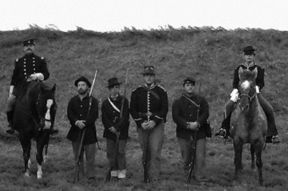
Detail of 4th Iowa Mounted Rifles on review showing Cpl. Otis Freemont (second from right), commanded by the infamous General Nero Bates (mounted, far left).
"I went to work for the US Department of Defense at the end of the War. I first came to Emmetsburg in 1947 as part of a US military crash recovery team, to investigate the possible crash of one of our rockets from the White Sands Missile Range. We were on site here for the better part of two weeks, with consequently some free time on our hands. Myself and the team officers took a day to go fishing in the lake, and tour the armored cruiser Borealis, which had just been brought in. You can imagine my surprise when I saw the submarine and spoke with Captain Wassergott. It was amazing to discover what our experiment had acomplished."
Luftwaffe Lt. Colonel Werner Dorfmann, who, like Dr. Stahl, is now also employed by Aerodyne, shared a similar reaction.
"I couldn't believe it. When I retired from the Air Force in 1982, and came to Aerodyne in '83 at the behest of Dr. Stahl, I was simply astounded to discover that the 3036 had ended up here. I had heard some rumors after the war, of course, but simply discounted them and forgot all about it. You may imagine my profound surprise when I met Captain Wassergott over at Mcnamara's Band. At first I refused to believe it was him. Then he broke a bottle of St. Pauli Girl across his eyes, and I knew that it could be noneother than our old Eisenaugen himself. I wonder what Hitler and Göring would say if they knew? Hah!"
Naval Intelligence gave the U-3036 a thorough going over, and her advanced technology went on to play a key part in the US Navy's first nuclear submarine, the USS Nautilus. The crew were interned as Prisoners of War. At the end of the war, most were repatriated to Germany, but some, like Kapitain Wassergott, remained in the United States.
When General von Kleist-Schulenhorst was informed by this author of the whereabouts of the U-3036, he merely gave a knowing wink, and tapped the side of his shaved head with his riding crop. "But of course, Herr Campbell. I knew along what had become of her. It was my job to know. After the war, when I worked for the East German Intelligence Service, we had our own project going along similar lines. We in the East always knew that the best German scientists went to work for the Warsaw Pact after the war. That is an established fact."
When informed of his former colleague's remark, Dr. Stahl gave a dismissive snort. "That is nonsense!" he scoffed. "Our Germans were always better than their Germans! Look who won the Cold War!"
Although the U-3036 remains to this day as a tourist attraction in Five-Island Lake, managed by Korvetten-Kapitain Wassergott, most who go aboard her assume that, like the Krupp 77mm gun in Dragoon Park, she is just a war trophy. The United States Navy and the Federal Republic of Germany refuse to acknowledge that she came to Emmetsburg as the result of a last-ditch effort to win a lost war. An experiment that failed in its success.
Baron Otto von Hohenberg-Ristau joined the reconstituted Federal West German Navy in 1954. He retired with the rank of full Admiral in 1982. He is currently on the Board of Directors of Deutche Welle and Telefunken GmBh. and Aerodyne Propulsion Laboratories. He lives on his ancestral estates at Ristau-am-Main in Bavaria.
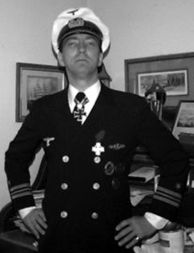
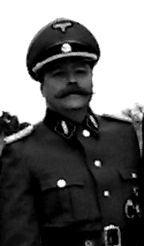
Bruno von Kleist-Schulenhorst the Waffen-SS officer in charge of security for the Kiel Experiment disappeared at the end of World War II. He later resurfaced as a General in the East German Staats Sicherheitsdienst (State Security Service, or Staasi). At the reunification of Germany in 1989, he and other high-ranking Staasi officers, was indicted by the Federal Republic for crimes against the German People. However, all charges against him were abruptly dropped. It is rumored that the ODESSA (Organization Der Eheligan SS Angeheregen) was behind this. General von Kleist-Schulenhorst is now a ranking member of the Bundesnachtrichtendienst, the German Federal Intelligence Service. He resides in Berlin.
Werner Dorfmann became an officer in the postwar German Luftwaffe. He retired from the military in 1982, and currently is an ad-hoc adviser to Aerodyne Propulsion Laboratories at the University of Emmetsburg. His specialty is Stealth Technology and Quantum Mechanics. Colonel Dorfmann is the author of a best-selling autobography, Schwartzadlers Angriff! The Life and Loves of a Paperclip. He is still more than willing to tell anyone who will listen about the time that Hermann Göring stepped on his foot.
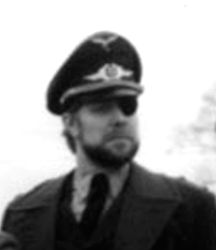
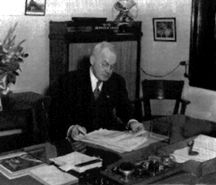
Dr. Immelmann Stahl, along with Werner von Braun and the rest of the rocket scientists at Peenemunde, surrendered to the American Army in early May of 1945. Dr. Stahl became one of the famous "paper clips", and assisted this country's space program, becoming a deputy director of NASA and instrumental in the Project Mercury, Gemini and Apollo Projects. In 1979, he resigned from NASA and was appointed head of Aerodyne Propulsion Laboratories at the University of Emmetsburg, where he now resides.
Otto "Eisenaugen" Wassergott lives in Emmetsburg, where he manages the U-3036, his last command. He resides in a large three-bedroom apartment above "McNamara"s Band", where he also is a part-time bartender, regaling patrons with his war stories and entertaining them by acting out the entire director's cut of Das Boot, and then puking in his beard and saying in slurred English, "I'm in no condition to fuck".
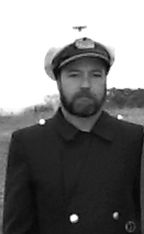
Otis Fremont, Civil War veteran and captor of the U-3036, died in 1947 at the age of 101. He was attending a reunion of surviving Grand Army of the Republic veterans in Chicago, entering a General Sherman look-alike contest. In the middle of a heated dispute with another contestant over who had the most authentic General Sherman impression, Mr. Fremont suffered a massive aneurysm. He died within minutes.
General Billy Sherman, Mr. Fremont's Rottweiller, was adopted by Kapitain Wassergott. He soldiered on until old age claimed him in 1959. Kapitain Wassergott had the animal stuffed, and he still can be seen at the main bar at McNamara's Band.
Back to this Issue Contents
